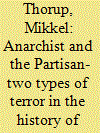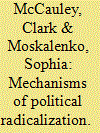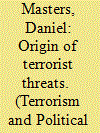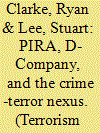|
|
|
Sort Order |
|
|
|
Items / Page
|
|
|
|
|
|
|
| Srl | Item |
| 1 |
ID:
082922


|
|
|
|
|
| Publication |
2008.
|
| Summary/Abstract |
This article deals with the anarchist and the partisan as forerunners of contemporary terrorism. It investigates their different relationship to the state, the anarchist trying to replace it and the partisan trying to conquer it and what that means in terms of resistance, critique, and position on the use of force. The article is both theoretical and historical, trying to place the anarchist and the partisan within their different time epochs and institutional settings. It ends by discussing if and how a third type of political violence, Islamist terrorism, can be interpreted within the analytical framework of legality/illegality and regularity/irregularity worked out in the article, that is, to what extent is current the Islamist terrorist a child of the anarchist and the partisan
|
|
|
|
|
|
|
|
|
|
|
|
|
|
|
|
| 2 |
ID:
082926


|
|
|
|
|
| Publication |
2008.
|
| Summary/Abstract |
This article conceptualizes political radicalization as a dimension of increasing extremity of beliefs, feelings, and behaviors in support of intergroup conflict and violence. Across individuals, groups, and mass publics, twelve mechanisms of radicalization are distinguished. For ten of these mechanisms, radicalization occurs in a context of group identification and reaction to perceived threat to the ingroup. The variety and strength of reactive mechanisms point to the need to understand radicalization-including the extremes of terrorism-as emerging more from the dynamics of intergroup conflict than from the vicissitudes of individual psychology.
|
|
|
|
|
|
|
|
|
|
|
|
|
|
|
|
| 3 |
ID:
082923


|
|
|
|
|
| Publication |
2008.
|
| Summary/Abstract |
This article offers a novel contribution to the terrorism literature by using mathematical modeling and case studies to demonstrate how terrorist and extremist groups can utilize social service provision activities and anti-corruption campaigns instead of violent activities to gain support.The basic argument of the model is that terrorist groups will try to gain support by promising that they will be better distributors of resources than the current regime once they gain power and by promising that they will be less corrupt. However, because all organizations can freely make these promises, their words are cheap talk, and the general population should ignore them. To overcome this problem, organizations must offer a costly signal. Provision of social goods and implementation of explicit anti-corruption campaigns before taking power serves as such a signal. As the United States government and its allies widen their "war on terrorism," they must consider the ramifications of social service provision and anti-corruption activities, which are common, effective, and potentially useful for increasing the probability of group success.
|
|
|
|
|
|
|
|
|
|
|
|
|
|
|
|
| 4 |
ID:
082925


|
|
|
|
|
| Publication |
2008.
|
| Summary/Abstract |
Recent studies indicate that the number of terrorist incidents is declining while their lethality is increasing. This trend in casualty rates has raised the rhetoric on terrorism, leading to claims that a new form of terrorism has emerged over the last thirty years. The "new terrorism" is defined by a tendency towards maximum destruction and a pronounced religious motivation. The question is whether or not the new terrorism is actually driving current trends in terrorist violence? This study examines casualty rates by terrorist groups categorized by their ideologies and finds that trends in terrorist violence are not being driven by the new terrorism per se. Instead, all forms of terrorism are more violent generally, and variations of ethno-national terrorism are the most violent specifically.
|
|
|
|
|
|
|
|
|
|
|
|
|
|
|
|
| 5 |
ID:
082924


|
|
|
|
|
| Publication |
2008.
|
| Summary/Abstract |
This article compares and contrasts the Provisional Irish Republican Army (PIRA) and D-Company, two seemingly dissimilar organisations that nonetheless share some striking commonalities, especially in regards to the use of tactics that contradict their declared ideology in pursuit of a larger goal. First, the growing relationship between organised criminal syndicates and terror groups is discussed and Makarenko's well-known "Crime-Terror Continuum" introduced. Following this, a historical overview and an analysis of the organisational structure of the PIRA is provided and organisational models proposed. Further, the founding and development of D-Company is addressed in addition to the syndicate's intricate involvement in the 1993 Bombay Blasts. Similarly, organisational models are offered and conclusions drawn. This work then moves to a comparative analysis of the organisational and operating structure of the PIRA and D-Company and finishes with a brief conclusion. This article argues that although criminal syndicates and militant groups may have different organisation structures, the line that distinguishes their activities has begun to blur and the space between Makarenko's graduated levels is becoming smaller and less discernible, thus rendering her model obsolete.
|
|
|
|
|
|
|
|
|
|
|
|
|
|
|
|
|
|
|
|
|